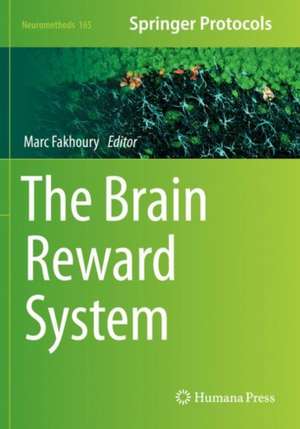The Brain Reward System: Neuromethods, cartea 165
Editat de Marc Fakhouryen Limba Engleză Paperback – 4 dec 2021
Cutting-edge and thorough, The Brain Reward System is a valuable resource for researchers interested in learning more about the current methods used to study the delineation of the brain reward system.
| Toate formatele și edițiile | Preț | Express |
|---|---|---|
| Paperback (1) | 1225.31 lei 43-57 zile | |
| Springer Us – 4 dec 2021 | 1225.31 lei 43-57 zile | |
| Hardback (1) | 1667.91 lei 43-57 zile | |
| Springer Us – 3 dec 2020 | 1667.91 lei 43-57 zile |
Din seria Neuromethods
- 5%
 Preț: 347.57 lei
Preț: 347.57 lei - 15%
 Preț: 659.53 lei
Preț: 659.53 lei - 15%
 Preț: 665.08 lei
Preț: 665.08 lei - 18%
 Preț: 986.63 lei
Preț: 986.63 lei - 24%
 Preț: 852.89 lei
Preț: 852.89 lei - 18%
 Preț: 953.03 lei
Preț: 953.03 lei - 18%
 Preț: 955.25 lei
Preț: 955.25 lei - 20%
 Preț: 1129.36 lei
Preț: 1129.36 lei - 20%
 Preț: 1252.04 lei
Preț: 1252.04 lei - 18%
 Preț: 1291.45 lei
Preț: 1291.45 lei - 15%
 Preț: 652.31 lei
Preț: 652.31 lei - 18%
 Preț: 955.70 lei
Preț: 955.70 lei - 23%
 Preț: 705.39 lei
Preț: 705.39 lei - 18%
 Preț: 973.38 lei
Preț: 973.38 lei - 18%
 Preț: 964.86 lei
Preț: 964.86 lei - 18%
 Preț: 968.03 lei
Preț: 968.03 lei - 15%
 Preț: 662.95 lei
Preț: 662.95 lei - 15%
 Preț: 646.43 lei
Preț: 646.43 lei - 15%
 Preț: 649.71 lei
Preț: 649.71 lei -
 Preț: 395.29 lei
Preț: 395.29 lei - 19%
 Preț: 580.67 lei
Preț: 580.67 lei - 19%
 Preț: 584.12 lei
Preț: 584.12 lei - 19%
 Preț: 566.41 lei
Preț: 566.41 lei - 15%
 Preț: 652.17 lei
Preț: 652.17 lei - 15%
 Preț: 655.13 lei
Preț: 655.13 lei - 18%
 Preț: 959.36 lei
Preț: 959.36 lei - 15%
 Preț: 652.49 lei
Preț: 652.49 lei - 15%
 Preț: 649.54 lei
Preț: 649.54 lei - 15%
 Preț: 649.87 lei
Preț: 649.87 lei - 15%
 Preț: 650.19 lei
Preț: 650.19 lei - 15%
 Preț: 648.42 lei
Preț: 648.42 lei - 18%
 Preț: 1039.22 lei
Preț: 1039.22 lei - 18%
 Preț: 963.15 lei
Preț: 963.15 lei
Preț: 1225.31 lei
Preț vechi: 1494.28 lei
-18% Nou
Puncte Express: 1838
Preț estimativ în valută:
234.46€ • 245.45$ • 194.00£
234.46€ • 245.45$ • 194.00£
Carte tipărită la comandă
Livrare economică 07-21 aprilie
Preluare comenzi: 021 569.72.76
Specificații
ISBN-13: 9781071611487
ISBN-10: 1071611488
Pagini: 366
Ilustrații: XIII, 366 p.
Dimensiuni: 178 x 254 mm
Greutate: 0.66 kg
Ediția:1st ed. 2021
Editura: Springer Us
Colecția Humana
Seria Neuromethods
Locul publicării:New York, NY, United States
ISBN-10: 1071611488
Pagini: 366
Ilustrații: XIII, 366 p.
Dimensiuni: 178 x 254 mm
Greutate: 0.66 kg
Ediția:1st ed. 2021
Editura: Springer Us
Colecția Humana
Seria Neuromethods
Locul publicării:New York, NY, United States
Cuprins
Intracranial Self-Stimulation and the Curve-Shift Paradigm: A Putative Model to Study the Brain Reward System.- Stereotaxic Surgery in Rodents for Stimulation of the Brain Reward System.- Characterizing the Neural Substrate of Reward with the Use of Specific Brain Lesions.- Assessment of Adult Hippocampal Neurogenesis: Implication for Neurodegenerative Diseases and Neurological Disorders.- Fast-Scan Voltammetry for In Vivo Measurements of Neurochemical Dynamics.- Carbon Fiber Probes for Real-Time Monitoring of Dopamine.- Immune-to-Brain Signaling Effects on the Neural Substrate for Reward: Behavioral Models of Aversion, Anhedonia, and Despair.- Behavioral Tests for Assessing Pain and Nociception: Relationship with the Brain Reward System.- Chemogenetic (DREADD) Exploration of Circuits Mediating Reward-Motivated Attention.- Intracranial Self-Stimulation: Using the Curve-Shift Paradigm to Assess the Abuse Potential of Drugs.- Drug Self-Administration as a Model to Study the Reward System.- Viral Vectors for Studying Drug-Seeking Behavior.- Conditioned Place Preference Test for Assessing the Rewarding Effects of Drugs of Abuse.- Positron Emission Tomography of the Reward System.- In Vivo Electrophysiology for Reward Anticipation and Processing.- Fiber Photometry of Neural Activity in Specific Neural Circuit.- Two-Photon Microscopy for Studying Reward Circuits of the Brain.
Textul de pe ultima copertă
This volume explores the latest techniques used to better understand the brain reward system with respect to neurotransmitters, brain structures, and connectivity. This book aims to show readers tested laboratory protocols to study neural circuitry and biological processes implicated in reward, and in neuropsychiatric disorders such as substance use disorders. The chapters are organized into four parts. Part One addresses classical techniques to study the brain reward system, including the curve shift paradigm in intracranial self-stimulation, stereotaxic surgery in rodents, and the use of brain lesions. Part Two focuses on neurochemical, behavioral, and chemogenetic techniques such as immunofluorescence for assessing adult hippocampal neurogenesis, and fast-scan voltammetry. Part Three highlights methods used to assess the rewarding potential of drugs including intracranial self-stimulation combined with drug injection, and the use of viral vectors. The Fourth Part introduces imaging and electrophysiology techniques such as positron emission tomography, in vivo electrophysiology, and fiber photometry. In the Neuromethods series style, chapters include the kind of detail and key advice from the specialists needed to get successful results in your laboratory.
Cutting-edge and thorough, The Brain Reward System is a valuable resource for researchers interested in learning more about the current methods used to study the delineation of the brain reward system.
Caracteristici
Includes cutting-edge methods and protocols Provides step-by-step detail essential for reproducible results Contains key notes and implementation advice from the experts
